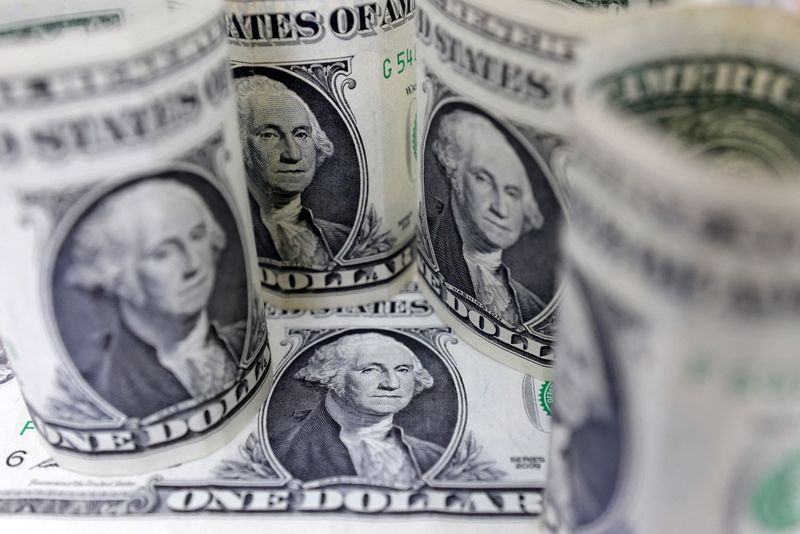By Saqib Iqbal Ahmed and Laura Matthews
NEW YORK (Reuters) - Investors are stampeding away from the dollar, as softer-than-expected U.S. consumer price data raises hopes that the Federal Reserve may need to tighten monetary policy less than expected in its fight against inflation and bolsters the case for risky assets.
Expectations of rising U.S. interest rates, volatile markets and geopolitical uncertainty have boosted the dollar over the last two years to a two-decade high against a basket of currencies.
While Thursday's inflation data alone may not be enough to limit the scope of the Fed's monetary policy tightening, it gave some investors confidence that consumer prices may have finally started trending lower, bolstering the case for them to cut their long dollar positions and dive into riskier assets such as stocks.
"The softer than expected core CPI number is driving the big down move in the dollar," said Van Luu, global head of currency at asset manager Russell Investments.
"Together with stretched valuation and sentiment ... it explains the magnitude of the drop."
The unwind of dollar positions has led to some eye-popping moves in currency markets, as investors pull back from trades in the foreign exchange market that many said has become crowded by historical standards.
At 2:45 p.m. (1945 GMT), the U.S. currency was down as much as 3.1% against Japanese yen, its sharpest one-day slide since June 2016. Against the euro, it was off by 1.5%, its biggest drop since Nov. 4. Against a basket of currencies , the dollar was off about 2%, on pace for its worst day in nearly seven years.
Meanwhile, equities rallied, with the S&P 500 and Nasdaq Composite up 4.7% and 6.2% respectively, their biggest one-day gains since April 2020.
GRAPHIC: This time it's different? https://graphics.reuters.com/USA-DOLLAR/zdpxdylndpx/chart.png
"The first major downwards surprise in U.S. inflation for a while has forced a lot of the leveraged trend followers to stop each other out," said Mike Riddell, a senior fixed income portfolio manager at Allianz (ETR:ALVG) Global Investors in London.
"The move lower in the U.S. dollar today is what would be expected given the rally in risk assets, based on correlations with bonds and risky assets over the last few months."
The consumer price index rose 0.4% in October to match the prior month's increase, the Labor Department said. Economists polled by Reuters had forecast the CPI would advance 0.6%.
The data sent U.S. Treasury yields tumbling, with the benchmark 10-year hitting 3.8387%, its lowest in about a month - narrowing gaps between yields on U.S. and foreign government debt that have burnished the dollar's appeal.
CROWDED TRADE
Worries over a violent reversal in the dollar have mounted in recent months, as the greenback extended a rally to a two-decade peak against a basket of currencies, gaining nearly 20% for the year.
As of Nov. 1, International Monetary Market speculators were net short 77,620 contracts on the Japanese yen, worth $6.54 billion, as well as sizeable bets against the British pound, the Australian and Canadian dollars, CFTC data showed.
"Because positioning imbalances have been around for some time there is the risk that we could see this period of dollar weakness extend as those still dollar long get cleared out," said Bipan Rai, North American head of FX strategy at CIBC Capital Markets.
A softer dollar would come as a relief to U.S. exporters and multinationals, whose balance sheets have been battered by a stronger currency this year, as well as emerging market economies that have borrowed in dollars.
Daniel Wood, portfolio manager on the emerging markets debt team at William Blair, has increased bets on emerging market currencies rising against the dollar.
"The market is less worried about financial conditions tightening. So, the dollar safe haven status is not so important," he said. "I think this is a microcosm of what's going to happen over the next year."
Still, plenty of investors are cautious about betting on a lasting dollar reversal. The dollar index has fallen by 3% or more three times over the last two years, only to resume its upward trend, making some investors cautious about betting on a reversal.
Signs that inflation is picking up again could quickly undercut the case for more dollar downside, as could a variety of other factors, including geopolitical or economic uncertainty that sends investors scrambling back to so-called safe havens.

Jack Ablin, chief investment officer at Cresset Capital, is watching key technical levels, including the 200-day moving average for the dollar index for indications that the U.S. currency may be on its way to a longer decline – a potential signal of positive sentiment that would advocate for increasing stock positions in his portfolios.
"If we start to see a real trend in the dollar decline, that to me is an indication that it is safe to get back into equities," he said.